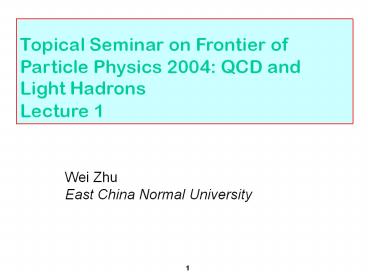Probing small x gluon with low mass Drell-Yan dilepton - PowerPoint PPT Presentation
Title:
Probing small x gluon with low mass Drell-Yan dilepton
Description:
Collinear Factorization Scheme. Parton(Scattering) and Dipole pictures ... Assuming a soft gluon collinear attaches to this hard quark with the momentum k p. ... – PowerPoint PPT presentation
Number of Views:94
Avg rating:3.0/5.0
Title: Probing small x gluon with low mass Drell-Yan dilepton
1
Topical Seminar on Frontier of Particle
Physics 2004 QCD and Light Hadrons Lecture 1
Wei Zhu East China Normal University
2
Outline of my three lectures
- What is the structure function
- definition and tools
- Definition
- Time Ordered Perturbation Theory
- Collinear Factorization Scheme
- Parton(Scattering) and Dipole pictures
- Factorization, parton distributions
- and evolution equations
- DGLAP Equations
- BFKL Equations
3
- Small x physics
- Introduction
- Modified DGLAP Equations
- JIMWLK Equation
- Phenomenology of Saturation
- A Geometric Nuclear Effect
4
Outline of Lecture One
- Definition
- Time Ordered Perturbation Theory
- Collinear Factorization Scheme
- Parton(Scattering) and Dipole pictures
5
1.Definition
Leptonic tensor
Hadronic tensor
6
Structure Functions
Wµ? has total 16 components
- Parity Invariance
Wµ? W? µ for spin-averaged symmetric
- Time-reversal Invariance
Wµ? W? µ real
- Current conservation
? µJ µem 0
Dimensionless Structure Functions
7
Polarized Structure Functions
transverse structure function
longitudinal structure function
projection operators
8
(No Transcript)
9
The kinematic domains probed by the various
experiments, shown together with the partons that
they constrain
10
(No Transcript)
11
Many Interesting Subjects Relating to SFs
- Factorization
- Evolution Dynamics
- Shadowing, Anti-shadowing
- Saturation, Color Glass Condensation
- Higher Twist Effects
- Nuclear Effects
- Spin Problem, Polarized SFs
- Asymmetry of Quark Distributions
- Diffractive SFs
- Large Rapidity Gap
- Generalized (skewed) Parton Distributions
12
Research Tools
- Operator Product Expansion
- Renormalization Group Theory
- Covariant Perturbation Theory
- Time Ordered Perturbation Theory (TOPT)
- Parton (Scattering) Model
- Dipole Model
- Pomeron Theory
13
2.TOPT
History
14
(No Transcript)
15
CVPT
CVPT
TOPT
After contour integral l0? (F) or -
? (B)
16
(No Transcript)
17
(No Transcript)
18
General Rule For TOPT
19
Propagating momentum
Off-mass-shell On-energy-shell
CVPT
On-mass-shell Off-energy-shell
TOPT
20
Application Weizsäcker-Williams(equivalent
particle) Approximation
3
3
3
3
1
1
1
1
2
2
2
2
21
Collinear TOPT (massless) W.Zhu, H.W.Xiong and
J.H.Ruan P.R.D60(1999)094006
finite
suppressed
22
(No Transcript)
23
Elementary Vertices of QCD
Elementary Vertices of QED
24
(No Transcript)
25
Propagating Momentum is but not k !
B
F
F
B
26
ApplicationEikonal approximation
Emission of absorption of soft particle cause
hardly any recoil to a fast moving source.
The eikonal approximation origins in the
application of Maxwell electromagnetism theory to
geometric optics by Bruns (1895).
In the quantum electrodynamics field theory, the
eikonal approximation implies that the
denominator of the relativistic propagator, which
connecting with the soft photon can be
linearized. In this case, the contributions from
the soft photos to the hard source can be summed
as an exponential. Therefore, the eikonal
approximation is an idea tool in the treatment of
the corrections of the soft gluons to the high
energy processes.
27
A massless quark moving along light-cone y-
direction with a large momentum.
Assuming a soft gluon collinear attaches to this
hard quark with the momentum k ltltp.
A0
F
F
F
B
Pk
Pk
P
P
B
k
F
k
0
Therefore, we can only keep the forward- and
backward-components for a fast quark and soft
gluon, respectively.
28
A similar conclusion holds for a fast gluon
F
F
µ
?
P
Pk
a
k
B
ß
A fast parton moving along the y--direction can
not collinear couple with any gluons in the
light-cone gauge since the vertex with two
collinear backward partons are inhibited.
Wilson Line
29
3. Collinear Factorization Scheme
30
(No Transcript)
31
?
?
?
F
F
F
k
B
F
F
F
Collins, Soper, Sterman
32
4. Parton(Scattering) and Dipole pictures
33
The transverse coefficient function with one
quark-loop correction are described by the
absorptive part of the amplitudes
34
Sudakov variables
Transverse coefficient functions
35
LLA
TOPT
36
p gtgt q-, Figure (a)
37
q-gtgtp, figure (b)
38
(No Transcript)































